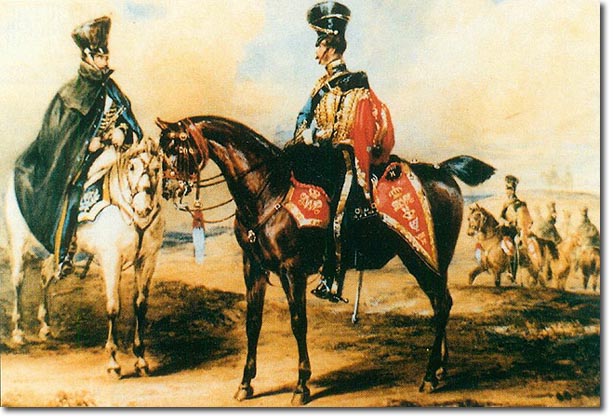|
|

 |
|
The extravagances of hussar uniform that had developed in the 1820s were curbed to some extent in the 1830s. One of the least sensible economies was the officers' undress uniform. Instead of the former special pattern jacket and pelisse which had much less braid, they were ordered, in the 1834 dress regulations, to retain the full dress jacket and pelisse for undress. These items were very expensive and would have been easily ruined on a wet field day. The officer, in the centre of this print by Henri Martens, has other regulation items of undress which are more suitable, such as the oil-skin covered shako, the black patent leather pouch-belt, waist-belt, and sabretache.
The shabraque here is scarlet, and the throat-plume is red and white, whereas the Officer c1833 has a blue shabraque and black throat-plume. Since Martens has shown the officer's dress almost correctly it would be hard to argue that he has made a mistake with the colour of the horse furniture. The dress regulations describe the hussar shabraques as scarlet but this order only applied to full dress because undress saddlery was to have the leopard-skin. However, the 10th and 15th hussars had red shabraques in full dress while the 8th had blue and the 7th had blue with red vandykes. The 15th had an undress shabraque for officers, but quite plain, being blue with red vandykes and no embroidery. It may well be that the officers of the 8th also had an undress shabraque. But there is a wealth of embroidery here, and there seems to be a border of gold lace. This may be an error as the lace on the officer's trousers is also gold where it should be yellow cloth in undress. The private is well wrapped in his cloak and is mounted on a grey horse which has a blue shabraque and white sheepskin. One would have expected this man to be a trumpeter, as they were normally mounted on greys. But he is holding a carbine not a trumpet. Most prints and paintings of the 8th Hussars of this period show the other ranks wearing oilskin covers to their shakos. They were serving in England at the time and were under a strict regime of hard discipline since receiving a detrimental report from Major-General Dalbiac who inspected them in 1831. Their time may well have been spent in frequent field days and marches. |
Armed Forces | Art and Culture | Articles | Biographies | Colonies | Discussion | Glossary | Home | Library | Links | Map Room | Sources and Media | Science and Technology | Search | Student Zone | Timelines | TV & Film | Wargames